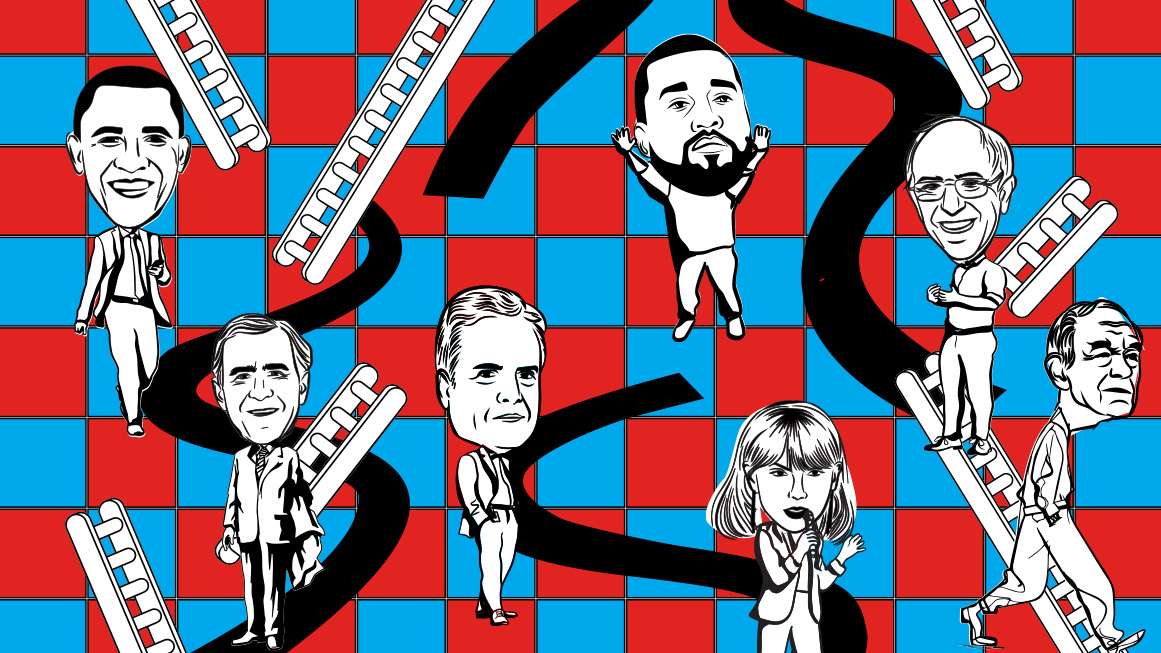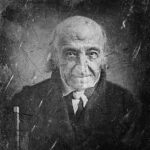The political landscape of two decades ago seems almost unrecognizable now. Back then, opposing wars and the surveillance state was so completely coded as left-wing that Republicans regularly denounced Ron Paul as a liberal squish. Some of the same cable news pundits who cheer for Democrats today were almost universally viewed as paladins of the right. Vaccines weren’t really seen as a left/right issue at all—and if you pushed people to tell you which tribe was more open to anti-vaxxism, they’d likely as not point to the crunchy left.
Some of the changes since then simply reflect shifts in particular individuals’ images or opinions. (If you think too hard about what the politics of the Taylor Swift/Kanye West beef used to be, you’ll get a headache.) But there’s been a deeper transformation too. Ponder that phrase I just used: “the crunchy left.” In an era when the conservative press is increasingly prone to publishing paeans to alternative diets and cottagecore lifestyles, how many people still think crunchy implies left in the first place?
When George W. Bush was president, Alex Jones was a vaguely countercultural figure who had cameos in Richard Linklater movies and filled his website with denunciations of police brutality. Insurgent liberals tried to claim a little populist cred by styling themselves “libertarian Democrats.” There was serious talk of asking Sen. Jim Webb (D–Va.)—a Second Amendment-friendly Vietnam veteran who celebrated Southern Scots-Irish culture and admired the Jacksonian populist tradition—to be Barack Obama’s running mate. Partly for the contrast, yes, but also because both were early critics of the Iraq War.
A decade later, there was serious talk of asking Webb to be Donald Trump’s secretary of defense. I don’t think Webb’s worldview changed substantially in that period. So what did? How did the political spectrum get turned inside out?
Crises and Coalitions
The easy answer would be that our maps of the spectrum are constantly evolving, as different issues emerge, disappear, and grow or shrink in salience. While COVID-19 was raging, the conservative New York Post ran a story about the Hong Kong flu of 1968–69, pointing out that no one was social distancing at the Woodstock festival; the effect was to make that hippie mecca sound like a monument to old-fashioned American grit and resilience. I don’t think many conservatives in 1969 spoke of Woodstock in those terms. But by 2020, “What do you think of hippies?” was no longer a significant political question and “What do you think of COVID?” was.
Yet the changes I’m describing here go beyond that sort of constant churn, for at least three reasons. The first is the presence of another political dimension beyond left and right: a factor that nine academics, writing in 2021 for the American Journal of Political Science, called an “anti-establishment orientation.” The people who adopt this worldview, these scholars wrote, distrust “the established political order irrespective of partisanship and ideology.”
I’ll be using that term a bit more broadly than the folks who coined it do. They define the orientation as a particularly Manichean and conspiratorial sort of populism: As two of the authors, Adam Enders and Joseph Uscinski, put it in a follow-up paper for The Forum, the worldview involves “an innate struggle between the good ‘people’ and a nefarious, self-serving ‘establishment.'” But I’ll be roping in a broader range of Americans whose politics are shot through with distrust for powerful institutions, even if they’re also cynical about ordinary people or think our leaders are more misguided than evil. The important thing for our purposes is that this distrust operates independently of “left-wing” and “right-wing” concerns. It might lead someone to jump from supporting Bernie Sanders to Donald Trump to Robert F. Kennedy Jr.
The second reason these changes go beyond the normal year-to-year churn is education polarization: Voters with college degrees are increasingly likely to be Democrats, and voters without them to be Republicans. This isn’t a uniquely American phenomenon—similar diploma divides have opened in most Western democracies—and so it probably stems from more than just American causes. But as suburbanites with lots of schooling identify more often with the party deemed liberal, and as working-class people who didn’t go to college identify more often with the party deemed conservative, the definitions of liberal and conservative are bound to evolve. If some of those voters are closer to the antiestablishment orientation than to the conventional left or right, that will intensify the effect.
The third reason is a series of three events, each of which threw U.S. institutions into crisis mode: 9/11, the Great Recession, and the COVID pandemic. Besides their immediate direct effects on the country (by, say, killing nearly 3,000 people and destroying an iconic part of the New York skyline), these allowed the government to adopt emergency powers, reshaping society in more sweeping and pervasive ways. That put a different set of issues at the center of our debates, sparking rapid changes in our political coalitions. And since many of those new policies enriched or empowered large, hierarchical social institutions, the antiestablishmentarians were especially open to finding new allies.
Each of those events also coincided, more or less, with a switch in which party occupied the White House, making the landscape even more fluid. The 9/11 attacks came just eight months after Bush entered the Oval Office, transforming what until then looked like it might be a low-key presidency whose biggest foreign policy concern would be trade with Mexico. The Great Recession began while Obama was running for president, and it arguably ensured his election; Joe Biden, similarly, took power while the pandemic was underway.
The one change in presidencies that did not coincide with one of these emergency events came with Trump’s election in 2016. Needless to say, a large swath of the country regarded his arrival as an emergency too, though the beginning of his term didn’t bring the kind of big, sudden shifts in public policy that we saw after 9/11 or the financial meltdown. (Before COVID hit, Trump’s most substantial changes to the system lay in the judges he appointed. And it is the nature of judicial appointments to show their impact in the long term: Trump made it possible to overturn Roe v. Wade, but not until Biden was in office.) Trump’s rise to power was itself a consequence of two crises—it is difficult to imagine him being elected in a world without the war on terror or the Great Recession. But since his election fell between crisis events, we will treat it as a separate turning point.
We can use those milestones to divide the 21st century into several distinct eras, each with its own distinct political landscape. The first few months of the millennium, with the country led by a lame-duck Bill Clinton and then a peacetime George W. Bush, were more an extension of the last century than a part of the new one. Then we got the period from 9/11 to the Great Recession, the period from the recession until Election Day 2016, and the period from Trump’s win until COVID. Americans then retreated into their homes (or were told to, anyway) before emerging into—well, we’ll get to what we emerged into soon enough.
First, let’s revisit that time between the first two crises. In particular—since all sorts of interest groups and voting blocs have drifted from one coalition to another in this century, and we haven’t space to cover them all—let’s focus on that most footloose force in politics, the antiestablishment sector.
From the Fall of the Towers to the Fall of Bear Stearns
In the wake of 9/11, the most conspicuous topic of debate was terrorism. Officials invoked the threat of another attack to justify everything from the occupation of Iraq to the detentions at Guantanamo Bay.
There were other issues, of course. The GOP mobilized socially conservative voters by campaigning against gay marriage, a concept that was much more controversial then. And Democrats defeated a Republican plan for the quasi-privatization of Social Security—itself a sign that the spectrum had been reshuffled, given that a Democratic president had been working on a bipartisan quasi-privatization plan just seven years earlier. (The impeachment fight of 1998 derailed it.) But no matter how excited people got about entitlements or same-sex unions, the political spectrum centered around the war on terror. And that didn’t change until the housing and banking dominos started falling in 2007–08.
At the beginning of this era, public horror over the September 11 attacks gave the administration wide latitude to respond as it pleased. Shortly after 9/11, a Gallup poll showed 88 percent of the public backing the initial military operation in Afghanistan. Only one member of Congress—the California progressive Rep. Barbara Lee—voted against the resolution that authorized it. The rump opposition was a mix of leftists, libertarians, and paleoconservatives, and even these groups were divided, with many figures favoring at least a limited response to the assault. (At Antiwar.com, Justin Raimondo published a column a few weeks after 9/11 headlined “Kill ‘Em—and Get Out.” ) At this point, in fact, many antiestablishment sorts were enthusiastically pro-war: In the wake of a foreign attack, it’s not hard for a suspicious nature to be turned more toward enemies abroad than enemies in high places. Indeed, if they become convinced that some of their domestic enemies are agents of those enemies abroad, those suspicions can at least temporarily turn populists into enthusiastic enforcers of the state of emergency—albeit ones whose eagerness to ferret out foes can disrupt the social order if it goes further than their rulers prefer.
Iraq was much more controversial than Afghanistan. While Democratic leaders lined up to support the war, there was a fair amount of dissension among the party’s rank and file, fueling Howard Dean’s insurgent 2004 presidential campaign and energizing the so-called netroots of online liberals. Four years after Dean’s campaign fizzled, a freshman Illinois senator named Barack Obama, who had opposed the Iraq invasion, snatched the party’s presidential nomination from Hillary Clinton, who hadn’t.
While a number of prominent pro-war bloggers described themselves as libertarians, the main libertarian institutions, from the Cato Institute to the Mises Institute to the Libertarian Party, opposed attacking Iraq. (Reason published arguments on multiple sides of the issue, though the editor and most of the magazine staff opposed the war.) There was also a small group of antiwar conservatives centered around The American Conservative, who didn’t really have a political home. (When the magazine invited 18 writers to weigh in on the 2008 election, more of them backed Obama than the Republican, though the majority refused to vote for either one.) All this created more space for antiestablishment left/right/libertarian cooperation.
With dissident Democrats feeling excluded both from the government and from their party’s leadership, for example, there was a small genre of think pieces about the alliances that might emerge if liberals found their inner libertarian or libertarians found their inner liberal. In Salon in 2005, future Reason editor Matt Welch declared that the “Republicans are now the party of big government and optimistic Wilsonian adventures abroad, while the Democrats flirt anew with federalism, fiscal sobriety and sour isolationism”; he urged the Dems to go all-in on Wild West antiauthoritarianism. The following summer, Daily Kos‘ Markos Moulitsas claimed to have identified a new breed of “libertarian Dems,” though on closer examination libertarian turned out to be his way of rebranding modern American liberal: In Moulitsas’ account, the libertarian Democrat defends the Bill of Rights but also wants an active government to protect us from corporations. At the end of the year, Brink Lindsey, then based at the Cato Institute, wrote a New Republic story headlined “Liberaltarians.” He wasn’t very enthusiastic about the politicians Moulitsas had been hailing, but he still was hopeful about fusing “libertarian means and progressive ends.”
If any of this was to manifest itself in political activity on the ground, as opposed to the dreams of bloggers and columnists, pundits expected it to appear in the Southwest or the Rockies, where Democrats were used to courting leave-me-alone voters. Writing in The New Republic right after the midterm elections of 2006, Thomas B. Edsall suggested that “a new Democratic ideology—pragmatic, culturally conservative, libertarian—has begun to emerge in the Mountain West.” He noted that Jon Tester, one of Moulitsas’ alleged libertarian Democrats, had just won Montana’s Senate race with a campaign that did not merely attack the USA PATRIOT Act but in the process managed to outflank his Republican opponent on gun rights. Edsall concluded that the Western Dems transcended the divide between the Clintonian centrists and the left, making them “uniquely well-positioned to help break the Democrats’ ideological logjam.”
Needless to say, that isn’t what happened. No one calls Tester a libertarian anymore. Maybe Colorado Gov. Jared Polis carries that old Mountain West flag, but he’s an outlier. In the Democrats’ 2008 presidential primaries, the candidate who came closest to embodying Moulitsas’ prototype—former Alaska Sen. Mike Gravel—didn’t get many votes; he eventually made a bid for the Libertarian Party’s nomination instead. Ironically, the 2008 candidate who best embodied the hopes of the people calling for a liberal-libertarian alliance was running in the Republican primaries: By arguing forcefully against the Iraq quagmire, wartime restrictions on civil liberties, and Bush’s corporatist economic policies, Rep. Ron Paul (R–Texas)—himself a former Libertarian presidential nominee—made many progressive doves swoon.
The same impulse that had netroots liberals flirting with libertarians also had them flirting with populists. Sometimes they crossed the streams: One of the figures identified as a “libertarian Dem” in Moulitsas’ article was Webb, who appealed to some libertarians with his arguments against the Iraq War and for criminal justice reform but whose views on trade and other issues ultimately put him in a different category. Indeed, Webb’s platform of economic populism and foreign-policy restraint felt almost—dare I say it?—America First.
When the Obama team reached out about giving Webb the vice presidential slot, the Virginia senator shot the idea down by declaring that he had no interest in the office. (“After being approached several times by the campaign and by Obama himself,” Webb recalls, “I declined to be considered at all.”) If you want to imagine a really different configuration for the political spectrum today, imagine a timeline where Webb took the job and became Obama’s designated successor.
Speaking of America First: The country music legend Merle Haggard acquired a right-wing reputation during his first burst of fame in the 1960s and ’70s, thanks to listeners who took his songs “Okie From Muskogee” and “The Fightin’ Side of Me” as hippie-hating anthems. But his politics were always more complicated than that, and even before 9/11 he had a history of worrying about government surveillance and intrusion. A little less than a year after the attacks, he made a wisecrack about Bush’s attorney general at a concert in Kansas City: “I think we should give John Ashcroft a big hand—right in the mouth!” (He added: “The way things are going I’ll probably be thrown in jail tomorrow for saying that, so I hope y’all will bail me out.”) In 2003 he recorded “Lonesome Day,” which imagined a future when “the men in black come kickin’ in your door / and guitar-playin’ outlaws lay spread-eagled on the floor.” And by 2005 he was explicitly calling for pulling out of the Middle East in a song called, yes, “America First“:
Our highways and bridges are falling apart
Who’s blessed and who has been cursed?
There’s things to be done all over the world
But let’s rebuild America first…






